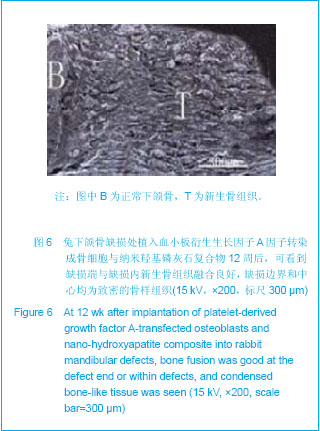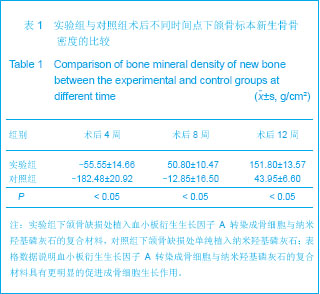| [1] Tan YY,Shao Y,Li YX,et al. Zhongguo Zuzhi Gongcheng Yanjiu. 2012;16(21):3843-3846.谭羽莹,邵英,李玉新,等.改性纳米羟基磷灰石/聚乳酸-聚羟乙酸复合骨髓基质干细胞修复兔桡骨缺损[J].中国组织工程研究, 2012,16(21):3843-3846.[2] Okuda K, Kawase T,Momose M,et al.Platelet-rich plasma contains high lebels of platelet-derived growth factor and transforming growth factor-be ta and modulates the proliferation of periodongtallhy related cells in vitro. J Periodontol.2003;74(6):849-857.[3] Feng QL,Cui FZ,Zhang W,et al.Zhongguo Yixue Kexueyuan Xuebao. 2002;24(2):124-128.冯庆铃,崔福斋,张伟.纳米羟基磷灰石∕胶原骨修复材料[J].中国医学科学院学报,2002,24(2):124-128.[4] Liao SS,Cui FZ,Zhang W. Zhongguo Yixue Kexueyuan Xuebao. 2003;25(1):36-38.廖素三,崔福斋,张伟.组织工程中胶原基纳米骨复合材料的研制[J].中国医学科学院学报,2003,25(1):36-38.[5] Zuo SL,Gong YK. Zhongguo Zuzhi Gongcheng Yanjiu. 2012; 16(14):2621-2624.左思力,龚跃昆.骨髓间质干细胞及细胞因子在股骨头坏死治疗中的应用与展望[J].中国组织工程研究,2012,16(14): 2621-2624.[6] Yu KT,Zou JC,Huang HY,et al.Zhongguo Zuzhi Gongcheng Yanjiu. 2012;16(15):2843-2847.于开涛,邹敬才,黄红艳,等.双膦酸盐类药物相关性颌骨坏死病例报告及最新进展文献复习[J].中国组织工程研究,2012,16(15): 2843-2847.[7] He SJ,Zheng H,Ni WD.Zhongguo Zuzhi Gongcheng Yanjiu. 2012;16(20):3611-3615.何盛江,郑华,倪卫东.重组人血管内皮生长因子165/重组人骨形态发生蛋白2/脱蛋白骨与深低温冷冻骨成骨能力的比较[J].中国组织工程研究,2012,16(20):3611-3615.[8] Pan L,Kang JM.Zhongguo Zuzhi Gongcheng Yanjiu. 2012; 16(20):3797-3800.潘乐,康建敏.腺病毒介导的骨形态发生蛋白基因增强在骨组织工程中的应用[J].中国组织工程研究,2012,16(20):3797-3800.[9] Liu C,Wu PD,Guo SG,et al.Guangdong Yixue. 2007;28(6): 871-873.刘城,吴平生,郭寿贵,等.腺病毒介导突变体HIF-1α基因对大鼠血管平滑肌细胞增殖的影响[J].广东医学,2007,28(6):871-873.[10] Zhang L,Xu H,Ge LH,et al. Beijing Kouqiang Yixue. 2010;18 (5): 246-248.张莉,徐辉,葛丽华,等.腺相关病毒介导VEGF促进新骨形成的实验研究[J].北京口腔医学,2010,18(5):246-248.[11] Li K,An YH,Li JH,et al.Zhonghua Shiyan Waike Zazhi. 2006; 23(2): 214-215.李晋,安沂华,历俊华,等.神经干细胞和施万细胞共移植治疗大鼠脊髓损伤[J].中华实验外科杂志,2006,23(2):214-215.[12] Xiao HJ,Xue F,He ZM,et al.Zhongguo Zuzhi Gongcheng Yanjiu. 2012;16(16):2879-2883.肖海军,薛峰,何志敏,等.纳米羟基磷灰石/羧甲基壳聚糖-海藻酸钠复合骨水泥与骨髓基质细胞的生物相容性[J].中国组织工程研究,2012,16(16):2879-2883.[13] Zhang Y,Zhong LJ,Zhang PT,et al.Zhongguo Zuzhi Gongcheng Yanjiu. 2012;16(1):125-129.张远,钟良军,张鹏涛,等.小型猪富血小板血浆对牙周膜干细胞的成骨诱导[J].中国组织工程研究,2012,16(1):125-129.[14] Deng TZ,Lu J,Peng JL,et al. Beijing Kouqiang Yixue. 2010; 18(5):257-260.邓天正,吕晶,逄键梁,等.细胞凋亡在糖尿病大鼠牙周炎中参与牙槽骨吸收的实验研究[J].北京口腔医学,2010,18(5):257-260.[15] Cao CF.Neijing:Renmin Weisheng Chubanshe. 2000:36.曹采方.牙周病学[M].4版.北京:人民卫生出版社,2000:36.[16] Lu H,Tian Y,Wu ZF.Zhongguo Zuzhi Gongcheng Yanjiu. 2012; 16(8):31443-1446.鲁红,田宇,吴织芬.松质骨基质材料应用于牙周组织工程的可行性[J].中国组织工程研究,2012,16(8):31443-1446.[17] Ding JY,Wei L,Guo JP.Zhongguo Zuzhi Gongcheng Yanjiu. 2012;16(16):3033-3036.丁建勇,魏琳,郭家平.不同类型移植直材料修复牙周牙槽骨缺损[J].中国组织工程研究,2012,16(16):3033-3036.[18] Xie LN,Pan JL. Beijing Kouqiang Yixue. 2009;17(2);115-117.谢丽娜,潘巨利.骨生长因子的研究进展[J].北京口腔医学,2009, 17(2);115-117.[19] Abukawa H,Zhang W,Young CS,et al.Reconstructing mandibular defects using autologous tissue-engineered tooth and bone constructs.J Oral Maxillofac Surg.2009;67(2): 335-347.[20] Robey AB,Spann ML,Mcauliff TM,et al.Comparison of miniplates and reconstruction plates in fibular flap reconstruction of the mandible.Plast Reconstr Surg.2008; 122(6):1733-1738.[21] Komiyama A,Klinge B,Hultin M.Treatment outcome of immediately loaded implants installed in dedntulous jaws following computer-assisted virtual treatment planning and flapless surgery.Clin Oral Implants Res.2008;19(7):677-685.[22] Yan J,Liu L,Wang F,et al.Potential use of collagen-chitosan-hyaluronan tri-copolymer scaffold for cartilage tissue engineering.Artif Cells Blood Substit Immobil Biotechnol.2006;34(1):27-39.[23] Park JB,Matsuura M,Han KY,et al.Periodontal regeneration in class Ⅲ fureation defects of beagle dogs using guided tissue regenerative therapy with platelet-devived growth factor. J Periodontol.1995;66(6):462-477.[24] Howell TH,Martuscelli G,Oringer J.Poly peptide growth factors for periodontal regeneration. Curr Opin Periodontol.1996;3: 149-156.[25] Zhang YL,Li CF.Zhongguo Zuzhi Gongcheng Yanjiu. 2012; 16(13): 2332-2335.张云龙,李长福.牙种植中数字化曲面断层与锥体束CT应用的对比[J].中国组织工程研究,2012,16(13):2332-2335.[26] Chen P,Liu B,Mao TQ.Beijing Kouqiang Yixue. 2009;17(4): 195-198.陈鹏,刘冰,毛天球.纳米羟基磷灰石/胶原/聚乳酸材料复合自体骨髓基质细胞修复犬下颌骨节段性缺损的实验研究[J].北京口腔医学,2009,17(4):195-198.[27] Huang QH,Sun RY.Guowai Yixue:Shengli Bingli Kexue yu Linchuang Fence. 1998;18(1):83-85.黄群华,孙仁宇.血小板源生长因子受体的研究进展[J].国外医学:生理、病例科学与临床分册,1998,18(1):83-85.[28] Yang LB.Guowai Yixue:Yichuanxue Fence. 2001;24(4): 228-230.杨孔宾.基因治疗的安全性评价[J].国外医学:遗传学分册,2001, 24(4):228-230.[29] Sun H,Jiang M,Zhu SH.Zhonghua Erbi Yanhou Toujing Waike Zazhi. 2008;43(1):51-57.孙虹,蒋明,朱晒红.用羟基磷灰石纳米粒作内耳基因治疗新载体的体内外研究[J].中华耳鼻咽喉头颈外科杂志,2008,43(1): 51-57. |





.jpg)